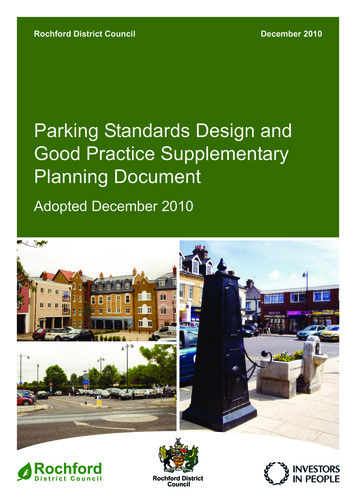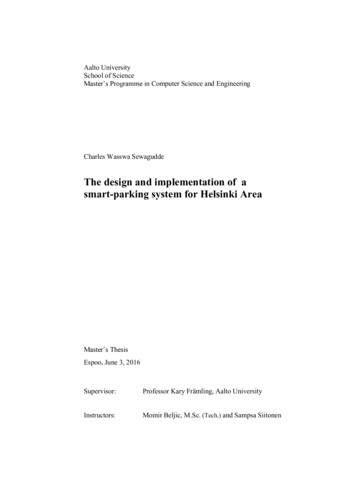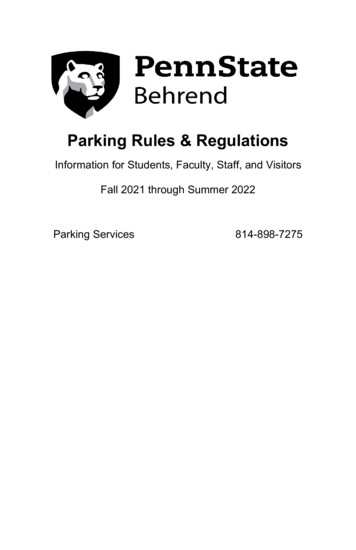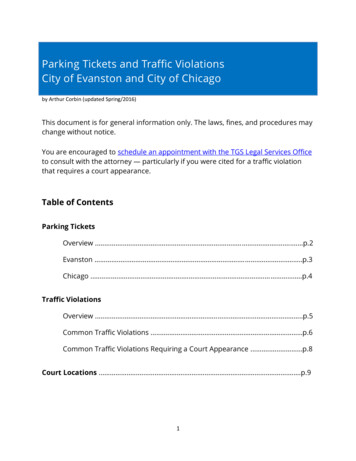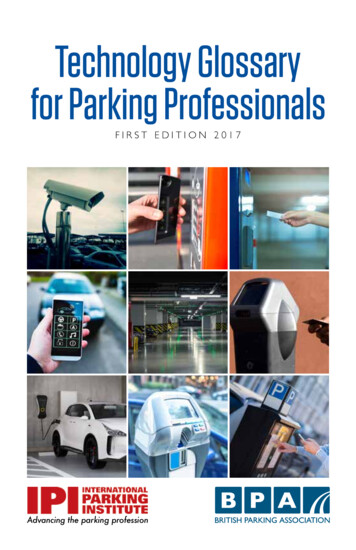
Transcription
Technology Glossaryfor Parking ProfessionalsFIRST EDITION 2017THE LOGOThereThere areare fourfour versionsversions ofof thethe BPBPPantone302orCMYKequivalenPantone 302 or CMYK equivalentinttint versionsversions shouldshould bebe used.used. WhWhonwhiteorreversedwhiteouton white or reversed white out ooAdvancing the parking profession
Technology Glossaryfor Parking ProfessionalsFIRST EDITION 2017During the past several years, the use of technology hasaccelerated in the parking and transportation industry.With these advances come new terms and changes to somedefinitions of terms we thought we knew. This glossary willhelp you better communicate with your peers, vendors, and thepublic when discussing parking technology.Words printed in red are defined elsewhere in this document.Access ControlManaging the access into and out of a parking facility and usually involvessome kind of permit, voucher or other ID to enable access.Access Control System (ACS)A system of hardware and/or software that controls access to facilities.AlarmAlarms may be used in access control and revenue control systems; these aresystem-generated messages that indicate potential problems with equipmentor operational rules that have been broken (i.e. vehicle entered lane and thenbacked out).Alarms may also be generated by users of the parking facility to request helpor assistance.Alternate Side ParkingA traffic regulation that prohibits car parking on one side of the streetbetween certain hours of the day.INTERNATIONAL PARKING INSTITUTE 2BRITISH PARKING ASSOCIATION
Anti-Passback or Passback ControlA setting that requires ACS users to enter and exit in proper sequence withtheir parking credential (i.e., entry, exit, entry, exit, etc.). Anti-passback istypically selectable as either “hard” or “soft:” Hard anti-passback rejects ACS users that are out of sequence, and shouldbe set to send an alarm at the ACS controller and Facility ManagementSystem (FMS). Soft anti-passback allows out-of-sequence ACS users to enter and exit, butreports and records violations with an alarm at the FMS for follow-up bythe parking manager. Soft anti-passback provides a more customer-friendlyexperience while monitoring for misuse. This setting should be unique foreach user.In both hard and soft modes, each out-of-sequence event is reported as anexception transaction in the daily ACS access log. Many systems have thecapability to clear the anti-passback condition via a password-protectedresynchronisation of the user’s account.AppA self-contained program or piece of software designed to fulfil a particularpurpose; an application, especially as downloaded by a user to a mobile device.Atomic ClockAn extremely accurate clock in which an electrical oscillator is controlledby the natural vibrations of an atomic or molecular system. Used in manyparking systems to ensure accuracy and consistency of time between differentsystems.Authoritative Data SourceThe system that has ownership of data or processes. Many systems canaccess the data, but only an authoritative system maintains the original recordand controls changes to the data.EXAMPLE: The Driver and Vehicle Licensing Agency is the authoritativesource of vehicle registration marks and keeper records information. Aparking operation might use this information but is not allowed to change/alter it because the parking operation is not the authoritative source.Automatic Number Plate Recognition (ANPR)A vehicle identification technology that uses cameras to take pictures ofnumber plates, read the images via character recognition software, andconverts the images into text that a computer can use. ANPR is common inaccess control, tolling, and speed management applications.INTERNATIONAL PARKING INSTITUTE 3BRITISH PARKING ASSOCIATION
Automated Pay Station (APS)Allows for automated ticket processing in central cashiering facilities. It cansupplement and/or replace cashiers. Sometimes called a pay-on-foot or payon-exit machine. Can accept multiple forms of payment and provide receipts.Automatic Vehicle Identification (AVI)A system that enables automatic identification of a vehicle when it entersa parking facility so it can be authorized and permitted to enter and exit.AVI access methods include Radio Frequency Identification, ANPR, andProximity cards.Autonomous VehicleVehicles which can drive themselves without human supervision or input.Unmanned vehicles are either controlled remotely, or perhaps operateautonomously. There are various levels of autonomy.BarcodeAn optical, machine-readable representation of data that can be printed on acredential. There are many barcode formats, including Code 39 (3 of 9), Code128, PDF417, QR, etc.BarrierThe hardware used to control access to a facility or car park.BatchAn interface that collects data for periodic updates versus providing areal-time stream of data.Bay SensorSensors that are placed in the ground on a lane or level of a facility to detecta vehicle passing overhead. They track occupancy by identifying the presenceof a metal object passing over the sensor, or laser or video. Two-sensor (orthree-sensor) systems can provide directional logic for vehicles entering orexiting a facility. Two-sensor means, for example, that two sensors are laid inthe ground next to each other.Blue Badge Scheme TechnologyThe badges rely on a combination of technologies, including; complex printingpatterns, a holographic feature, use of security inks available from a restrictedlist of providers, a central database of all badge holders, raised features andbraille, 2D barcodes and a digital photograph. These technologies allow civilenforcement officers to carry out checks using desktop PCs, handheld devicesor SMART phones.INTERNATIONAL PARKING INSTITUTE 4BRITISH PARKING ASSOCIATION
BollardA short post, generally three to five feet tall that is used to create a visual orprotective perimeter.Bulk PermitsA stack of permits purchased all at once. For example, a department or officemay purchase bulk permits for a special event to pass out to its guests.Cardholder Information Security Program (CISP)A program from VISA related to handling sensitive credit card data. For themost part, this has been replaced by PCI-DSS.Card-In, Card-OutAn operating model that allows a customer to use a payment card as anaccess credential to enter and exit a parking facility. The credit card acts bothas credential and payment mechanism. The advantage of credit card use forentry and exit is that the customer is not required to have a ticket. There arealso significant revenue security advantages.Car Park Management Systems (CPMS)Represents multiple parking technologies beyond access and revenuecontrol, which typically apply to off-street parking facilities. Other systemsrepresented by CPMS include meter revenue systems, parking guidancesystems, systems that track occupancy, and other systems that do notnecessarily include access and revenue control.Check DigitA form of redundancy check used for error detection on identificationnumbers that have been input manually. For example, the ninth digit in a car’sVehicle Identification Number (VIN) is always a check digit. The other digitsin the VIN go through a series of calculations to obtain the correct checkdigit. This allows computers to tell immediately if there is an error in the VIN,which often happens when someone transcribes a VIN or enters it into acomputer.Chip and PINA credit card payment method of accepting any EMV smart card technologythat relies on an embedded chip in the credit card to be inserted into anEMV- approved payment device and the user to enter a 4-digit PIN to approvea payment transaction.Chip and SignatureA credit card payment method of accepting any EMV smart card technology,which relies on an embedded chip in the credit card and verification with asignature by the user instead of an encoded 4-digit PIN. This is similar to theverification used by current magnetic stripe based credit cards.INTERNATIONAL PARKING INSTITUTE 5BRITISH PARKING ASSOCIATION
Chip CardAlso known as an integrated circuit card (ICC), refers to any pocket-sizedcard with embedded integrated circuits (aka computer chip) with specialisedmemory.Versions include both read-only and read-write.Cloud/Cloud ComputingA service, application, or infrastructure hosted on a third-party virtualmachine or data centre. Cloud computing allows the user to reduce oreliminate hardware and software by purchasing it as an on-demand serviceaccessible via the internet.Coin Box/VaultA secured container for storage of coins and/or bills, normally removable fortransport to a secure area for counting of contents.Coin HopperA compartment for storage of coins, usually segregated by denomination.Coin ShutterA cover for a coin entry slot that stops dust and contaminants from enteringthe machine.Concession AgreementA form of public-private partnership agreement in which the private entitypays the government agency a large upfront lease payment for the longterm (in excess of 50 years) rights to all ongoing revenues generated by asystem previously held by the government agency. Generally speaking, thehours of operation and parking rates (bylaws) are defined in the agreementand can change based on a prescribed schedule. Further changes to theoperation’s bylaws can result in additional payment(s) made by the privateentity to the government agency or vice versa depending on the long-termeffect on the parking asset. In most cases, upon commencing the concessionagreement, the private entity upgrades the parking technology used withinthe system; all operating and capital expenditures are the responsibility of theconcessionaire.Connected CarA car that is equipped with internet access, and usually also with a wirelesslocal area network. This allows the car to share internet access to otherdevices both inside and outside the vehicle. They provide additional benefitsto the driver. Examples include: automatic notification of crashes, notificationof speeding and safety alerts.INTERNATIONAL PARKING INSTITUTE 6BRITISH PARKING ASSOCIATION
Contactless Payments SystemThese are credit cards and debit cards, key fobs, smart cards or other devicesthat use radio-frequency identification for making secure payments. Theembedded chip and antenna enable consumers to wave their card or fob overa reader at the point of sale.Control Equipment Networks and SystemIs a system for remote monitoring and control that operates with codedsignals. The signals collectively monitor, sense, and control or enable controlof an environment for a particular purpose.Communications LatencyThe amount of time between a request by a user and a response from themachine being used, i.e. time from insertion of a credit card to the finalising ofthe transaction.Comprehensive Asset Management Plan (CAMP)Provides a long-term asset management approach to plan for and minimizethe cost of buying, operating, maintaining, replacing, and disposing of parkingrelated capital assets.Counting SystemA system used to track the number of motorists parked using sensors (loops,infrared, cameras, etc.) that vehicles pass through or over. Also referred to asan occupancy system.CredentialAlso referred to as a permit, allows access to a facility or to park in acertain on-street area (i.e. residential parking pass) and referencesaccess control systems.Credit Card ChipAn integrated circuit embedded in a credit card that can store read/writabledata and perform encryption programs that improve transaction security.Credit Card GatewayThe infrastructure that allows a merchant to accept credit cards, connectwith a processor or bank, and process credit card payments. Specifically, thegateway is a service that connects the location’s credit card device/server tothe credit card processor’s system.Credit Card ProcessingThe ability to take, validate, and authorise credit cards for payment.INTERNATIONAL PARKING INSTITUTE 7BRITISH PARKING ASSOCIATION
DashboardRefers to a web-based page on which real-time information is collated fromvarious sources. The metaphor of a dashboard is adopted to emphasize thenature of the data being displayed on the page; it offers real-time analysis as tohow a business is operating.Data AnalyticsThe examination and analysis of data to reach a conclusion, make a decision,or improve a process.Data Protection ActThe Data Protection Act 1998 is an Act of Parliament of the UnitedKingdom of Great Britain and Northern Ireland which defines UK law onthe processing of data on identifiable living people. It is the main piece oflegislation that governs the protection of personal data in the UK.Data WarehouseAn electronic repository of data and information that can be collected frommany sources. It retrieves information from authoritative sources in batch orreal-time, and provides the ability to perform business analysis searches andqueries on the data.Declining Balance Card/Stored Value Card/Campus CardA card or account that stores a set amount of value available to a motorist.The motorist (cardholder) cannot spend more than the pre-loaded amount,but usually has the ability to add value to the card. May also be called aneWallet. These systems are typically found in Parking Access and RevenueControl.Demand-Based PricingPricing parking supply based on demand. Generally speaking, the price ofparking.Department for Business, Innovation and Skills (BIS)A ministerial department of the UK Government, responsible for policy inmany areas including, business regulation and support, innovation, science andresearch, and skills.Driver and Vehicle Licensing Agency (DVLA)Maintain registers of drivers and vehicles in Great Britain.Electronic CouponA document provided in electronic form that allows the user to receive adiscount for a service or product. Electronic versions normally contain abarcode to be read by a scanner.INTERNATIONAL PARKING INSTITUTE 8BRITISH PARKING ASSOCIATION
EMV (Europay, MasterCard, and Visa)A global standard for inter-operation of integrated circuit cards (IC cards orchip cards) and IC card-capable point of sale (POS) terminals and automatedteller machines (ATMs), for authenticating credit and debit card transactions.EMV chip cards contain embedded microprocessors that provide strongtransaction security features not possible with magnetic stripe cards.Encoding StationConnected to a ticket validator, these computers are typically used toallow a cashier to update the magnetic stripe of a parking ticket with newinformation (rate, payment, etc.).EncryptionThe placement of data into a coded format that can only be read with anencryption “key” or formula that translates the data into a readable format.Entry Lane StationAn in-lane cashier station or booth in the entry lane to a facility that maybe used to collect payment for parking; dispense token, ticket, or other itemindicating time of entry or validity of vehicle; or detect permits or otherpermission to enter.EthernetA type of networking technology. An Ethernet cable is a type of connectionthat is very common for communication between various pieces of hardware.An Ethernet cable is often used in communication between a computer andother devices such as router, switch, handheld ticket writer’s downloadingcradle, etc.EventThis has two meanings in the parking world: A special event with resources allocated to it, such as a parade, sportsgame, city event, or other activity or meeting that is in duration andrequires its own dedicated inventory, unique pricing, or both. An occurrence that may trigger an alarm via a the Parking Access andRevenue Control System (PARCS) in a facility. In this instance, everythingthat happens in a facility is an event (some systems refer to facility eventsas incidents to avoid confusion).Exception TransactionA non-cash transaction in a parking facility, such as use of a voucher or phonetransaction to pay for parking.INTERNATIONAL PARKING INSTITUTE 9BRITISH PARKING ASSOCIATION
Exit VerifierAlso called an exit station, hardware in a lane into which the motorist insertsa dispensed ticket showing that they paid. The hardware verifies payment andraises the barrier.Extend-By-PhoneUsed in conjunction with mobile payments to allow motorists to add timeto their parking sessions via phone (where permitted). In some cases a textmessage will be sent alerting the motorist that their time is about to expire.Motorists can add time by either texting, using an app, or telephoning.Facility Management System (FMS)The computer system and software that provides real-time reporting,monitoring, and controlling of access control. In essence, this represents thebrains of the computer system.Fee Computing Station or Fee StationEquipment used to process payment, either as pay-on-foot, on-exit or at acentral pay station.FirmwareA software program or set of instructions programmed on a hardware device.Firmware is typically stored in the flash ROM of a hardware device where itcan be erased and re-written.Geo-Fence/GPS FenceA virtual perimeter around a specific point or area on a geographical map/area. This could be a small or large radius around a desired location set, andpersonnel are notified when a device enters or exits the area.General Packet Radio Service (GPRS)Technology that enables data transfer through mobile networks.This technology is applicable for text, mobile internet, and other datacommunications but not voice service. This term has relevance in parking asthere is very often a need for data transfer among different areas of a parkingoperation. For example, individual pay stations must communicate informationback to servers and enforcement devices will communicate with permitdatabases to verify parking eligibility.Global Positioning System (GPS)A space-based satellite navigation system used for location tracking. Thissystem has many applications in parking. For example, GPS is used to trackparking enforcement activity, including officers’ movement and ticket issues.INTERNATIONAL PARKING INSTITUTE 10BRITISH PARKING ASSOCIATION
Global System for Mobile Communications (GSMC)A standard for digital mobile network communications for the transferof both data and voice. This term has relevance in parking as there is veryoften a need for data transfer among different areas of a parking operation.For example, individual pay stations must communicate information back toservers and enforcement devices will communicate with permit databases toverify parking eligibility.Handheld Computer/UnitA computer that is small enough to be held in one’s hand; used to recordevidence and issue parking tickets.In-car TagA piece of equipment used as a hangtag inside a vehicle. Money is linked tothe pay machine and the customer uses those funds when he activates thepay machine to park.Incremental RatesA method for adjusting rates based on current demand. This allows theparking management entity to maximize revenue during peak demand hourswhile encouraging additional parkers during off-peak or lower demand hours.One method for using incremental rates might be based on a study of thepeak and off-peak hours, with rates based on the time of day and day ofthe week. Another method could be deployed dynamically by having ratesadjusted automatically based on real-time data that tracks available spaces.Innovate UKA national body set up by government to stimulate business innovationthrough a variety of funding tools.Integrated Circuit Card (ICC)A chip card or any pocket-sized card with embedded integrated circuits withspecialised memory.Versions include both read-only and read-write. ‘Chip andPIN’ credit/debit cards are a type of ICC that use the EMV standard.Intelligent MobilityAn approach to journeys using emerging technologies (including autonomousvehicles, seamless journey systems and multi-modal modelling software), toenable the smarter, greener and more efficient movement of people andgoods. Intelligent Mobility creates solutions for the challenges that havetraditionally beset the transport sector, whether it is congestion, pollution orthe lack of “joined up” thinking between different means of transport.INTERNATIONAL PARKING INSTITUTE 11BRITISH PARKING ASSOCIATION
InterfaceThe point where two different systems or subjects interact. For example thesoftware on a screen used by a person to manage a system is known as agraphical user interface (GUI). An interface between two systems (e.g. parkingmanagement and payment) is defined in an interface control document thatdefines how data is formatted and the rules for accepting data, this is oftencalled an Application Programming Interface (API).InteroperabilityThe ability of a system to work with other systems without the need forspecial adaptation. Interoperability often refers to how ‘open’ a system orproduct is (i.e. the willingness of its promoters to allow other systems tointeract).KeypadAn integral set of buttons arranged in a block or pad. Keypads are used asaccess methods or input devices on parking equipment. Keypads can bemechanical, membrane (either flat or domed), or touchscreen. Most keypadsare either alphanumeric (containing the entire alphabet and the numbers zeroto nine) or numeric (i.e. with numbers only, styled after a telephone).Lane ControllerA device or system that manages activity in a lane, activating and deactivatingequipment based on triggers such as vehicle presence. The lane controlleroften sends and receives data from an online central database, enabling overallmanagement of the facility.License AgreementA formal agreement or contract between parties that enable one party (thelicensee) to legally use the property of another party (the licensor). A licenseis not a transfer of property (as in a sale). Licenses may be allowed the useof software, intellectual property, physical property etc. They usually definethe conditions under which the property can and cannot be used and may besubject to a time limit.Low Emission Vehicle (ultra).Vehicles with electric engines, plug-in hybrid engines or cars with CO2emissions below 75 g/km at tailpipe. Also known in the UK as an “Ultra Low”car. A list of eligible vehicles is published on the gov.uk website.INTERNATIONAL PARKING INSTITUTE 12BRITISH PARKING ASSOCIATION
Magnetic StripeA strip of magnetic media usually found on a credential such as a credit card,hotel key, etc that can store a small amount of data. The term is sometimesshortened to mag-stripe. Magstripes come in two main varieties: highcoercivity (HiCo) low-coercivity (LoCo). High-coercivity magstripes requirehigher amount of energy to encode, are harder to erase, and therefore usedin applications such as credit cards. Low-coercivity magstripes require a loweramount of magnetic energy to record, but are much easier to erase and havea shorter lifespan. These are used in applications such as parking tickets. Highcoercivity stripes are resistant to damage from most magnets likely to beowned by consumers. Low coercivity stripes are easily damaged by even abrief contact with a magnetic purse strap or fastener.Magnetic Stripe Reader (MSR)A hardware device that reads the information stored on magnetic stripesand converts it to a signal that can be used by a computer or controller. Thereader must make contact with the stripe in order that the data can be readand is therefore subject to wear.Map-based TechnologyDevices and software that provide information to a user, or interactiveservices, through a map interface. Examples include sat nav devices, GoogleStreet Map etc. Map based apps are also often used in large venues such asshopping centres, campuses etc.Mesh Wi-FiA network of nodes (e.g. laptops, smartphones etc.) in which each node iscapable of relaying network signals to the others. This effectively extends thetransmission distance (coverage) of a WiFi network beyond that of the basestation or access point.Metro-Mesh or Metro-Scale networks describe the use of Mesh technology(usually specialist repeaters) to create a wide coverage over a built up area.Unlike a normal WiFi network, the capacity can be increased by adding morenodes.INTERNATIONAL PARKING INSTITUTE 13BRITISH PARKING ASSOCIATION
Mobile PaymentA payment made using mobile technology (e.g. a phone, smartphone ortablet). Initially in the UK the term was used to describe systems that allowedcustomers to pay for parking with a mobile phone as an alternative to coins.In fact this method is usually a way of using stored credit or debit cardinformation to pay for parking.A type of parking operation that enables a customer to pay using a mobilephone or smartphone app. The pay-by-mobile phone provider charges thecustomer for parking fees and reimburses the parking operator. Enforcementofficers audit by checking online databases for valid plates.The term mobile payment is now used to describe a wide range oftechnologies, including PayM and ApplePay that are accessed by the customerthrough their smartphone.Monitoring SystemA system that allows the user to view system-generated activity, alarms,occupancy and (optionally) CCTV and licence plate information within afacility.Multi-modal Transport ModellingA way of simulating a journey undertaken using more than one mode oftransport. Most journeys use more than one mode of transport (e.g. trainand bus, car and walking). When studying transport therefore, modelling thepattern of journeys need to include the different modes of transport thatmight be used.Multi-space MeterFreestanding hardware associated with multiple parking spaces, used in onstreet and surface operations to manage payment for multiple parking spaces.See ‘Pay-and-Display’Near Field Communication (NFC)A set of standards for smartphones and similar devices to establish radiocommunication between them by touching them together or bringing theminto close proximity, the most well-known examples of this technology arethe London Oyster card and contactless payment cards. NFC is a smallchip (often embedded in a mobile phone or a plastic card) with short rangewireless connectivity (defined as 4cm in the EMV payment standard) thatenables quick, secure financial transactions when the NFC enabled device isplaced on a reader device.In payments the technology has the potential to replace coins, tickets andphone calls as the parking payment solution of the future in the UK. NFCpayment chips are now also being embedded in “wearable” devices.INTERNATIONAL PARKING INSTITUTE 14BRITISH PARKING ASSOCIATION
NestA facility contained within another facility (called a “parent”). Nesting is oftenused to control access to a specific area within a larger parking facility via theuse of gates or barriers.Note Stacker (Note Vault)A device used to stack banknotes for collection after they have beenaccepted for payment by a note validator. The note stacker usually has aunique lock to secure the money when the stacker is removed for collections.Note ValidatorA device used in different parking technologies to accept only valid currenciesand read the denomination of banknotes accepted for payment. Notevalidators and stackers are usually combined in one device.Optical Character Recognition (OCR)Software used to “read” data by scanning text or images and convert theinformation into editable text. One major implementation of OCR in parkingis the ANPR system which also uses algorithms to identify likely charactercombinations on a licence plate.Park Assist System (PAS or IPAS)In car systems that assist drivers in parking their vehicle. On vehiclesequipped with the system, the car can steer itself into a parking space withlittle or no input from the user (often depending on whether the car hasmanual or automatic transmission). Cars can parallel or reverse park intospaces.Park and RideCar parks (usually provided at the periphery of urban areas) with publictransport connections. Park and rides enable motorists heading to urbancentres to leave their vehicles and transfer to a bus or train for the remainderof the journey.Parking Access and Revenue Control (PARC)/Access andRevenue Control (ARC)Systems that are available in varying levels of functionality and complexity.Parking access and revenue control systems (often referred to in Europeas Parking Management Systems) allow parking owners and operators tocontrol access and collect parking revenues from users. Available in varyingtypes of equipment platforms, PARC systems, when combined with policyand procedure, can speed entry and exit from a facility and secure revenuesthrough audit records.INTERNATIONAL PARKING INSTITUTE 15BRITISH PARKING ASSOCIATION
Parking AnalyticsUse of technology to collect and analyse parking occupancy and revenue datato plan for rates, hours, enforcement, new technology, and the possibility ofdynamic pricing. Data is displayed using a combination of graphics and keyindicators for easy viewing and analysis by parking management for strategicdecision making. Also often referred to as Business Insight tools.Parking Guidance SystemA system that provides guidance to available parking spaces. In a parkingfacility these systems can include dynamic signage and individual floor andspace availability indicators. Newer generation parking guidance systemsdetect individual space occupancy with space sensors and can also shareinformation with GPS-enabled vehicles and smartphone apps, which extendthem beyond a garage or car park. On street systems are emerging that usea variety of technologies (including scanning cars, individual sensors and/oralgorithms) to identify available spaces and smartphone apps to indicate tomotorists where spaces are available.Pay-and-DisplayA type of parking operation that requires the customer to pay at a pay stationin advance and place a ticket on their vehicle. The customer selects theamount of time and makes a payment. Enforcement officers audit by lookingin vehicles for tickets.Pay-by-PlateA variation of pay and display in which the customer is
Cardholder Information Security Program (CISP) A program from VISA related to handling sensitive credit card data. For the most part, this has been replaced by PCI-DSS. Card-In, Card-Out An operating model that allows a customer to use a payment card as an access credential to enter and exit a parking facility. The credit card acts both
